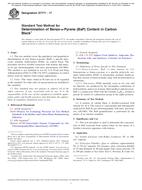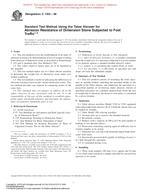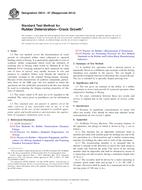1.1 This guide identifies methods to determine the physical and chemical characteristics of radioactive and/or hazardous wastes before a waste is processed at high temperatures, for example, vitrification into a homogeneous glass ,glass-ceramic, or ceramic waste form. This includes waste forms produced by ex-situ vitrification (ESV), in-situ vitrification (ISV), slagging, plasma-arc, hot-isostatic pressing (HIP) and/or cold-pressing and sintering technologies. Note that this guide does not specifically address high temperature waste treatment by incineration but several of the analyses described in this guide may be useful diagnostic methods to determine incinerator off-gas composition and concentrations.
The characterization of the waste(s) recommended in this guide can be used to (1) choose and develop the appropriate thermal treatment methodology, (2) determine if waste pretreatment is needed prior to thermal treatment, (3) aid in development of thermal treatment process control, (4) develop surrogate waste formulations, (5) perform treatability studies, (6) determine processing regions (envelopes) of acceptable waste form composition, (7) perform pilot scale testing with actual or surrogate waste, and/or (8) determine the composition and concentrations of off-gas species for regulatory compliance.
The analyses discussed in this standard can be performed by a variety of techniques depending on equipment availability. For example, Gas Chromatograph Mass Spectrometry (GC/MS) can be used to measure the amount and type of off-gas species present. However, this standard assumes that such sophisticated equipment is unavailable for radioactive or hazardous waste service due to potential contamination of the equipment. The analyses recommended are, therefore, the simplest and least costly analyses that can be performed and still be considered adequate
1.2 This guide is applicable to radioactive and/or hazardous wastes including but not limited to, high-level wastes, low-level wastes, transuranic (TRU) wastes, hazardous wastes, mixed (hazardous and radioactive) wastes, heavy metal contaminated wastes, and naturally occurring or accelerator produced radioactive material (NARM or NORM) wastes. These wastes can be in the physical form of wet sludges, dried sludges, spent waste water filter aids, waste water filter cakes, incinerator ashes (wet or dry), incinerator blowdown (wet or dry), wastewaters, asbestos, resins, zeolites, soils, unset or unsatisfactory cementitious wastes forms in need of remediation, lead paint wastes, etc. and combinations of the above. This guide may not be applicable to piping, duct work, rubble, debris waste or wastes containing these components.
1.3 This guide references applicable test methods that can be used to characterize hazardous wastes, radioactive wastes, and heavy metal contaminated process wastes, waste forms, NARM or NORM wastes, and soils.
1.4 These test methods must be performed in accordance with all quality assurance requirements for acceptance of the data.
1.5 This standard may involve hazardous materials, operations, and equipment. This standard does not purport to address all of the safety concerns, if any, associated with its use. It is the responsibility of the user of this standard to establish appropriate safety and health practices and determine the applicability of regulatory limitations prior to use.
Product Details
- Published:
- 07/10/2003
- Number of Pages:
- 19
- File Size:
- 1 file , 700 KB


